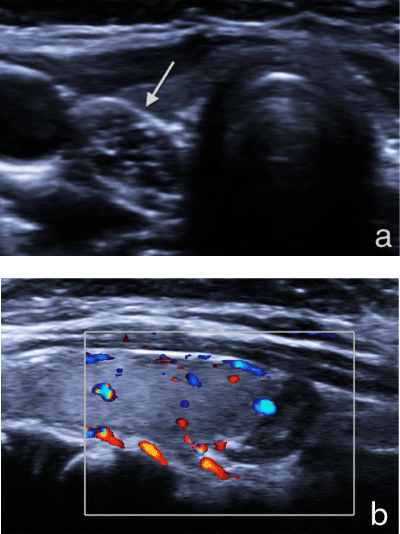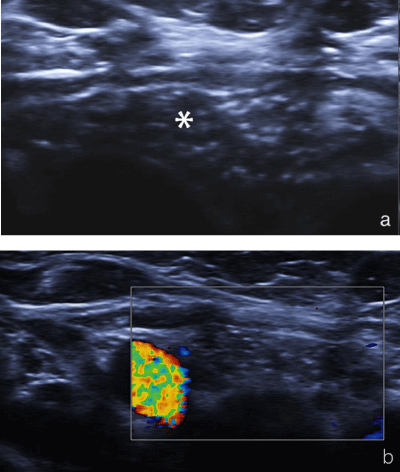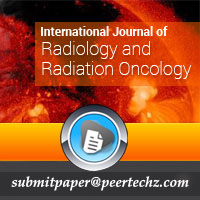International Journal of Radiology and Radiation Oncology
Acoustic Radiation Force Impulse Imaging in the Differential Diagnosis of an Ectopic Intrathyroidal Thymus
Dilek Sağlam1*, Meltem Ceyhan Bilgici1, Cengiz Kara2, Muzaffer Elmali1, Asli Tanrıvermiş Sayit1
2Ondokuz Mayıs University, Department of Pediatric Endocrinology, 55270, Atakum, Samsun, Turkey
Cite this as
Sağlam D, Bilgici MC, Kara C, Elmali M, Sayit AT (2017) Acoustic Radiation Force Impulse Imaging in the Differential Diagnosis of an Ectopic Intrathyroidal Thymus. Int J Radiol Radiat Oncol 3(1): 010-012. DOI: 10.17352/ijrro.000022Ectopic intrathyroidal thymus is caused by a hesitate in the migration of thymus during embryogenesis and is a rare cause of a nodular intrathyroidal lesion. Nodular thyroid lesions raise the suspicion of malignancy in the pediatric age group. Although rare, ectopic intrathyroidal thymus is usually misdiagnosed as a thyroid nodule and in addition to ultrasonography, further imaging techniques including MRI is performed. Fine needle aspiration biopsy or surgical excision, are also included in the management in thyroid nodules, because of the possibility of a malignancy. Acoustic Radiation Force Impulse-Imaging (ARFI) is a new method determining the tissue elasticity using short duration acoustic pulces and exciting the tissue in the selected region of interest. Acoustic Radiation Force Impulse-Imaging had been used in the differentiation of malign and benign thyroid nodules with or without in combination with gray-scale ultrasonography findings. We here present a case of intrathyroidal ectopic thymus in a 4 year-old boy diagnosed with the use of Acoustic Radiation Force Impulse-Imaging in addition to gray scale and Doppler ultrasonography findings.
Introduction
Ectopic intrathyroidal thymus is caused by a hesitate in the migration of thymus from the angle of the mandible to the anterior mediastinum during embryogenesis [1]. If misdiagnosed as a thyroid nodule, unnecessary interventions and inappropriate treatment may cause unwanted results [2]. Acoustic radiation force impulse-imaging (ARFI) is a quantitative method in determining tissue elasticity and had been used in differentiation of benign and malign thyroid nodules [3]. We here report a case of intrathyroidal ectopic thymus and to our knowledge this is the first case presenting the role of ARFI elastography findings in the differential diagnosis.
Case Report
A 4 year-old boy was referred to our outpatient clinique for fine needle aspiration biopsy from a solitary thyroid nodule. The thyroid nodule was detected with ultrasonography in another institution. The patient was reevaluated in our clinique. The patient had no family history for goiter. Physical examination was normal and thyroid gland was non-palpable. Anthropometric measurements were in normal range for age (height: 110, 5 cm- 27, 3 percentile; weight: 21, 1 kg- 70 percentile). Bone age was 5 and calendar age was 5, 5. Thyroid function tests were normal (free T3: 4, 32 pg/mL, free T4 1, 27 ng/dL, TSH: 5, 38 µIU/mL). Thyroid auto-anticores were negative (thyroglobulin: 13, 13 ng/mL, anti-thyroglobulin antibody: 13, 14 IU/mL, anti-TPO antibody 〈 5 IU/mL). There was not any symptom of a parathyroid adenoma and serum calcium, phosphor, ALP and parathormone levels were normal. Technetium- 99 m pertecnetate thyroid scintigraphy was performed and asymmetric uptake in the right and left lobes were detected.
A second ultrasonography was performed in our institution with Siemens Acuson S2000™ ultrasound system using an L9-4 MHz transducer. A 6x6x8 mm sized ovoid lesion in the right lower pole of thyroid was detected. The lesion had no distinct border to thyroid tissue, which leads us to think of an intrathyroidal localization. The lesion was hypoechoic and had multiple milimetric bright internal echoes on gray-scale ultrasonography. Doppler ultrasonography did not show a significant vascularity (Figure 1). Because of the similarity in gray scale and Doppler ultrasonography imaging findings to thymus when compared, the lesion was thought to be an ectopic intrathyroidal thymus (Figure 2). We performed ARFI elastography to support the diagnosis. ARFI elastography measurements from the normal thyroid parenchyma, from the lesion in the right lower pole of thyroid and from the anterior mediastinal thymus were done (Figure 3). Each measurement was repeated for five times and the mean value was recorded. The mean ARFI elastography velocities of the lesion and the mediastinal thymus were, 0, 63 m/s and 0, 60 m/s, respectively. The mean ARFI elastography velocity of the normal thyroid parenchyma was 1, 25 m/s. The normality of data distribution was evaluated with Saphiro-Wilk test and Paired sample T test was used to compare the mean SWVs in normal distributed data. There was not a significant difference between the mean SWV of the lesion and thymus (p=0.9). There was a significant difference between the mean SWV of the lesion and thymus versus thyroid gland (p=0.001 and p=0.002, respectively). The lesion was diagnosed as ectopic intrathyroidal thymus and follow-up was recommended.
Discussion
In the embryogenesis, thymus originates from the third and the fourth branchial pouchs on both side of the neck and descends to its final place, the anterior mediastinum. A hesitate in this migration process results in ectopic localization of the thymic tissue.
In children intrathyroidal lesions before puberty are rare and rise the suspicion of malignancy. Ectopic parathyroid gland, esophageal diverticula, lymphocytic thyroiditis, adenoma, nodular goiter, lymphoma and abscess are some of the lesions, which should be considered in the differential diagnosis of nodular thyroid lesions in children. Although rare, ectopic intrathyroidal thymus is one of the possible origins of a nodular lesion in the thyroid gland and several cases of intrathyroidal ectopic thymus in children had previously been reported [4,5].
Ultrasound is the first imaging study performed in the case of nodular thyroid lesions. Classical findings of well-defined margins, ovoid to fusiform shape on longitudinal axis, hypoechoic structure with multiple small echogenic foci are the typical ultrasonographic findings suggesting thymus tissue. Also the low lying or mid- localization of the thymus tissue will give a clue [6]. In the study of Han et al., the classical gray scale ultrasonography finding; linear echogenic septa in thymus was found to be the representative of the connective tissue septa and the vessels within the septa [7]. On Doppler ultrasonography thymus do not have prominent vascularity. ARFI elastography is a new method determining the tissue elasticity using short duration acoustic pulses and exciting the tissue in the selected region of interest. The tissue elasticity is measured in meters per second (m/s). This method provides quantitative information about tissue elasticity and is less operator dependent compared to strain elastography. Most commonly used in liver fibrosis to replace liver biopsy, ARFI elastography had also been used for the differentiation of malign and benign thyroid nodules and diffuse thyroid lesions in the literature [8,9]. Previous studies suggest ARFI elastography as a useful tool in the differentiation of malign and benign thyroid nodules with or without in combination with gray-scale ultrasonography findings [10-12].
Several cases of intrathyroidal ectopic thymus in children had previously been reported. Most commonly these lesions were misdiagnosed as a thyroid nodule on ultrasonography. In the previous cases, CT, MRI or sintigraphy had been used as conformational imaging studies [13]. Some of these patients underwent surgery for excision or biopsy was performed to exclude malignancy. To our knowledge this is the first time in the literature that the diagnosis was supported with ARFI elastography findings without the need for any other procedure. Although studies were carried out for ARFI elastography measurements of thyroid nodules and diffuse thyroid diseases in adults, to our knowledge, elastography values of normal or abnormal thyroid tissue in children had not been reported in the literature. Sporea et al., reported the means of ARFI in thyroid gland in healthy subjects as 2±0, 40 m/s [8]. Friedrich-Rust et al., in their study evaluating ARFI imaging in the thyroid gland; reported the median velocity in the healthy thyroid gland as 1.98 m/s, in benign thyroid nodules as 2.02 m/s, and in malignant thyroid nodules 4.30 m/s [5]. In their study, ARFI elastography values in benign nodules were similar to normal thyroid paranchyme whereas in malignant nodules elastography values were higher. In the present case, the mean velocity in the ectopic intrathyroidal thymus was similar to the mean velocity in the anterior mediastinal thymus, 0, 63 m/s and 0, 60 m/s, respectively. The mean ARFI elastography value in the normal thyroid parenchyma was significantly different from the previous two measurements, 1, 25 m/s.
There are some limitations in the use of ARFI elastography in the differential diagnosis of intrathyroidal ectopic thymus. As we mentioned above, there are studies evaluating the normal or abnormal thyroid gland in adults, but to our knowledge there is not a study evaluating these values in children and also ARFI elastography velocities of the normal thymus is not found, to make a reference point. Our decision in this case depends on our own clinical experience on elastography measurements of the thymus and thyroid glands. We think ARFI elastography helps in the differential diagnosis of ectopic intrathyroidal thymus and prevents unnecessary interventions.
- Nishino M, Ashiku SK, Kocher ON, Thurer RL, Boiselle PM, et al. (2006) The thymus: a comprehensive review. Radiographics 26: 335-348. Link: https://goo.gl/s8wmz9
- Vlachopapadopoulou EA, Vakaki M, Karachaliou FE, Kaloumenou I, Kalogerakou K, et al. (2016) Ectopic Intrathyroidal Thymus in Childhood: A Sonographic Finding Leading to Misdiagnosis. Horm Res Paediatr 86: 325-329. Link: https://goo.gl/0S6Yns
- Friedrich-Rust M, Romenski O, Meyer G, Dauth N, Holzer K, et al. (2012) Acoustic Radiation Force Impulse-Imaging for the evaluation of the thyroid gland: a limited patient feasibility study. Ultrasonics 52: 69-74. Link: https://goo.gl/TKCNgn
- Durmaz E, Barsal E, Parlak M, Gurer I, Karaguzel G, et al. (2012) Intrathyroidal ectopic thymic tissue may mimic thyroid cancer: a case report. J Pediatr Endocrinol Metab 25: 997-1000. Link: https://goo.gl/OQ1dpR
- Segni M, Di Nardo R, Pucarelli I, Biffoni M (2011) Ectopic intrathyroidal thymus in children: a long-term follow-up study. Horm Res Paediatr 75: 258-263. Link: https://goo.gl/BHlb0h
- Yildiz AE, Ceyhan K, Sıklar Z, Bilir P, Yağmurlu EA, et al. (2015) Intrathyroidal Ectopic Thymus in Children Retrospective Analysis of Grayscale and Doppler Sonographic Features. J Ultrasound Med 34: 1651-1656. Link: https://goo.gl/W9e6dN
- Han Bokyung K, HK Yoon, Yeon-Lim Suh (2001) Thymic ultrasound Pediatr Radiol 31: 480-487. Link: https://goo.gl/DQL8CZ
- Sporea I, Sirli R, Bota S, Vlad Mihaela P, Alina Zosin, et al. (2012) ARFI elastography for the evaluation of diffuse thyroid gland pathology: Preliminary results. World J Radiol 4: 174-178. Link: https://goo.gl/8ddM9K
- Kwak JY, Kim EK (2014) Ultrasound elastography for thyroid nodules: recent advances. Ultrasonography 33: 75-82. Link: https://goo.gl/SOO4My
- Bhatia K, Tong C, Cho C, Yuen EH, Lee J, et al. (2012) Reliability of shear wave ultrasound elastography for neck lesions identified in routine clinical practice. Ultraschall Med 33: 463-468. Link: https://goo.gl/oAxh3z
- Kim H, Kim JA, Son EJ, Youk JH (2013) Quantitative assessment of shear-wave ultrasound elastography in thyroid nodules: diagnostic performance for predicting malignancy. Eur Radiol 23: 2532-2537. Link: https://goo.gl/GK0w3u
- Sebag F, Vaillant-Lombard J, Berbis J, Griset V, Henry JF, et al. (2010) Shear wave elastography: a new ultrasound imaging mode for the differential diagnosis of benign and malignant thyroid nodules. J Clin Endocrinol Metab 95: 5281-5288. Link: https://goo.gl/T7m0sM
- Sahab SH, ChewYK, Yahya N, Han KM (2016) Cervical ectopic thymus: Surgery or conservative management? Rawal Medical Journal 41: 496-498. Link: https://goo.gl/XIkjIz
Article Alerts
Subscribe to our articles alerts and stay tuned.
 This work is licensed under a Creative Commons Attribution 4.0 International License.
This work is licensed under a Creative Commons Attribution 4.0 International License.




 Save to Mendeley
Save to Mendeley
